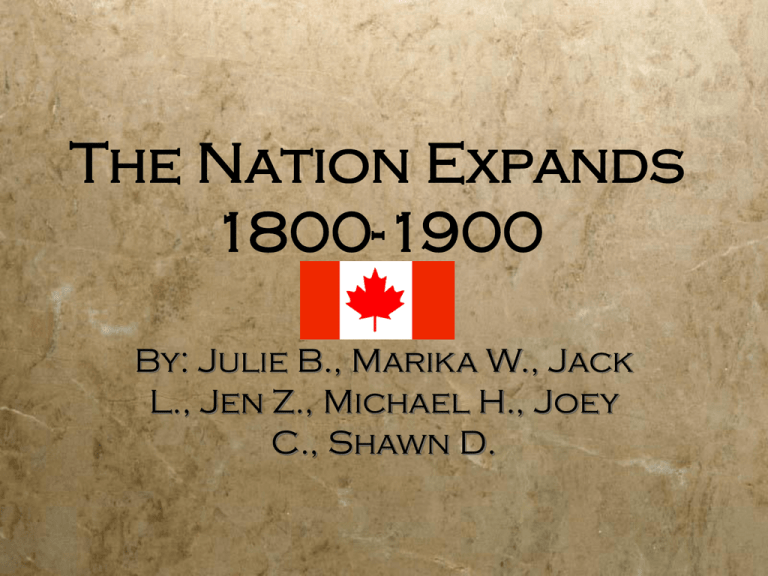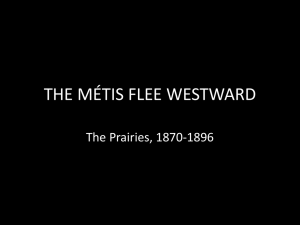Group 4
advertisement

The Nation Expands 1800-1900 By: Julie B., Marika W., Jack L., Jen Z., Michael H., Joey C., Shawn D. Rupert’s Land- Canada’s Interest In It Hudson bay Co. Formed trading furs only in Rupert’s Land. 1800 Eastern Canada (Ontario)- develop land- Canada believed land had economic value. 1857 expanded Rupert’s land. 1869 Canada bought land- 10x amount = 1500000. Canada in return got one tenth of Hudson Bay Co. The Rupert’s Land Act Paid $1,500,000 to Hudson’s Bay Co. for land After the Canadian government gained control, they called it the North-West Territory The Rupert’s Land Act allowed the British government to transfer Hudson’s Bay Co. lands to the Canadian government In 1869, the transfer took place, and the government did not plan to make it any part of it a province The act was passed in 1868, and Canada wanted to buy Rupert's Land The Hudson’s Bay Co. kept its fur fort and was given some large land grants in the west Rupert’s Land (North-West Territory) covered more than half of Canada The Red River Resistance & Louis Riel The Red River Resistance began at the Red River settlement; surveyors trespassed on the farms and lands of the Métis in the Red River Resistance. The Métis were extremely angered by the surveyors and the person who sent them, Sir William McDougal the lieutenant governor of the Northwest Territories. A National Committee of Métis was set up by Louis Riel to resist the surveyors, the National Committee also bargained with the Canadian Government for the lands and Métis rights. The Métis believed that William McDougal had no right to enter the settlement until the transfer of Rupert’s Land officially took place. The Métis had informed William McDougal that he could not enter the settlement without the permission of the inhabitants. The Métis soon made a List of Rights for themselves, which were the conditions by which they would join Canada. Métis List Of Rights To elect own legislative- Assembly pass all local laws To elect local sheriffs and constables Those treaties signed between federal governmentNative people around Both English-French be used in provincial legislature and courts all provincial documents and acts All existing customs, rights and privileges remain after joining Canada All existing customs, rights and privileges remain after joining Canada The Manitoba Act The area around the Red River settlement were to join Canada as a province On July 15th, 1870, Manitoba became a province The rest of Rupert’s land stayed a Territory Many points from the Métis list of rights became part of the Manitoba Act English and French were to be its official languages There were 2 government funded school systems; The Roman Catholic, and the Protestant The federal government retained control of the Crown Islands New Caledonia After the British claimed the Pacific coast, large companies were actively searching for furs in the area Vancouver Island became a British colony in 1849 There were fewer than 1000 settlers living on the island at that time The mainland, called New Caledonia had only a few forts A gold rush in 1858 brought over 30 000 miners to New Caledonia, many were from the United States In 1858 New Caledonia became another British colony and was renamed British Columbia In 1866 Britain united the two colonies with the name British Columbia By 1868 the colony was in debt British Columbia was in debt so they joined Canada and preserved British ties The joining of British Columbia to Canada is important to Canada’s nationhood because the colony brought natural resources, industry, etc. and helped make Canada what it is today New Caledonia (Now British Columbia) Newfoundland and the AntiConfederation Song NFL not invited to Charlottetown conference in 1864 because no one thought NFL would support it 2 important groups from population: business community and the Roman Catholics were strongly anti-Confederation Business group strongly anti-Confederation because they did not trade often with Canadians and were against political changes that might increase taxes or restrict freedom to choose their own trading partners 1874: Conservatives returned to power and would not force Confederation on N.F.L. Government started program of railway building Many business community members against railway because they thought it would lead to bankruptcy 1894: colony facing bank because prices for fish and seal oil dropped Delegation sent to Ottawa to negotiate terms so that NFL could join Confederation Terms did not work out and NFL did not join Confederation until 1949 Created Anti-Confederation Song Prince Edward Island Act July 1, 1873: PEI joined Canadian Confederation Because PEI joined the Confederation, Canadian Government gave PEI $800 00 to buy back land from absentee lords government paid all railway debts provided a $50 grant for every person living on the island ferry and telegraph services provided between PE.I. and mainland The Pacific Scandal The Pacific Scandal was an event based on the Canadian Pacific Railway; the scandal was mainly centered on the contract to build the railway. The Liberal Party of Canada accused the Conservative Party of accepting bribes from Hugh Allan; this accusation became a massive factor in the election of 1872. The Conservative Party of Canada and its leader; John A. MacDonald received bribes from Hugh Allan in exchange for the contract to build the Canadian Pacific Railway. The Conservatives claimed that they received “donations” from Hugh Allan for the 1872 election. The total amount of “donations” received by the Conservative Party was estimated to be around $350,000. Evidence of the scandal was found six days before the 1872 election; John A. MacDonald resigned as Canada’s Prime Minister as a result of the scandal. Alexander Mackenzie Mackenzie was born in perthshire, Scotland, 1822 He was the Second Prime Minister of Canada, and the first Liberal Prime Minister In 1873, Mackenzie became the leader of the liberal party and Prime Minister During the 1870s, the country began having issues, and Mackenzie’s Government was blamed Mackenzie lost the 1878 election to returning Prime Minister, Sir John A. Macdonald Mackenzie remained in parliament until the year he died, in 1882 Sir John A. Macdonald Returns: National Policy Alexander Mackenzie prime minister, liberals in control since 1873, but were experiencing economic problems. The Conservative party, under control of Sir John A. Macdonald, introduced a National Policy. National Policy had three parts: protective tariffs, National Railway and Settlement in the west. The Protective Tariffs were designed so that goods from other countries were more expensive than Canadian goods, so that Canadian industries would sell more of their own manufactured goods. SUCCESS The National Railway would take settlers to the West, and their crops to the East. SUCCESS Macdonald planned to help immigrants from other countries settle in the west. FAILURE Canadian voters responded positively to these ideas, and voted Macdonald back into power, along with the conservative party. The Canadian Pacific Railway (CPR) During the years from 1881- 1885, the CPR was built Stretching from Vancouver to Montreal, with headquarters in Calgary, Alberta, The CPR also served major cities in the United States It was Canada’s first transcontinental railway, which is now a freight railway The CPR is a national symbol of Canadian nationalism Need For The North West Mounted Police August 1873, parliament created special police for the west called North West Mounted Police (NWMP) The Canadian Government was concerned that American settlers would try to make the North West part of the United States An incident in Cypress Hills showed the great need for a police force, when a group of American traders shot and killed 30 Assiniboine people. In 1873, 300 men were sent to the west to patrol Respected highly by Canadians and Americans by the 1880s The NWMP gave friendly advice to new settlers, carried mail, fought fires and prevented open conflict among Native peoples, between Natives & non-Natives, and amongst settlers The Seven Treaties People wanted to move the natives so Europeans could settle John A. Macdonald believed that the First People should be assimilated into the Canadian culture In order to settle, the government had to isolate natives to reserves The “numbered treaties” were made by the government to resolve the land claims of the First People Seven treaties were signed form 1871 to 1877 between the government and the natives living between Lake Superior and the Rocky Mountains Between 1889 and 1921 four more treaties were signed









